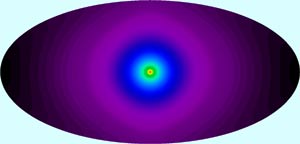
Handy Links
SLAC News Center
SLAC Today
- Subscribe
- Archives: Feb 2006-May 20, 2011
- Archives: May 23, 2011 and later
- Submit Feedback or Story Ideas
- About SLAC Today
SLAC News
Lab News
- Interactions
- Lightsources.org
- ILC NewsLine
- Int'l Science Grid This Week
- Fermilab Today
- Berkeley Lab News
- @brookhaven TODAY
- DOE Pulse
- CERN Courier
- DESY inForm
- US / LHC
SLAC Links
- Emergency
- Safety
- Policy Repository
- Site Entry Form

- Site Maps
- M & O Review
- Computing Status & Calendar
- SLAC Colloquium
- SLACspeak
- SLACspace
- SLAC Logo
- Café Menu
- Flea Market
- Web E-mail
- Marguerite Shuttle
- Discount Commuter Passes
-
Award Reporting Form
- SPIRES
- SciDoc
- Activity Groups
- Library
Stanford
Around the Bay
Gamma Rays from the Sun: A New Way for Looking at the Solar System
 Until now, gamma-rays emitted directly from the sun have been detected only during rare intense solar flares. However, a paper to be published by Igor Moskalenko of Stanford/SLAC, Troy Porter of SCIPP/UCSC, and Seth Digel of SLAC—in
Astrophysical Journal Letters in December—finds that collisions between cosmic-ray electrons and solar photons (sunlight) make the inner solar system a relatively-bright, diffuse source of gamma rays with energies 100 million to 1 billion times greater than visible light. Although the intensity is greatest near the sun, the entire sky glows faintly in high-energy gamma rays from this effect, which is known as inverse Compton scattering.
Until now, gamma-rays emitted directly from the sun have been detected only during rare intense solar flares. However, a paper to be published by Igor Moskalenko of Stanford/SLAC, Troy Porter of SCIPP/UCSC, and Seth Digel of SLAC—in
Astrophysical Journal Letters in December—finds that collisions between cosmic-ray electrons and solar photons (sunlight) make the inner solar system a relatively-bright, diffuse source of gamma rays with energies 100 million to 1 billion times greater than visible light. Although the intensity is greatest near the sun, the entire sky glows faintly in high-energy gamma rays from this effect, which is known as inverse Compton scattering.
This indirect gamma-ray emission from the sun will be readily detectable by GLAST, the gamma-ray astronomy mission scheduled for launch by NASA in late 2007. The main instrument on GLAST, the Large Area Telescope (LAT) was developed by an international collaboration including Stanford University/SLAC and SCIPP/UCSC.
Moskalenko and colleagues point out that LAT's detection of this diffuse glow will have many implications. The cosmic rays are high-energy electrons that originate elsewhere in the Galaxy. As they pass through the solar system, their intensity is modulated by the solar wind and the solar magnetic field. Gamma-ray measurements with the LAT will allow for the first accurate determination of the electron spectrum across the inner solar system, including measurements in close proximity to the sun where no spacecraft can be sent to study the electrons directly. This in turn will allow researchers to make accurate predictions of the proton spectrum in the close proximity to the sun. Collisions of these protons with the sun will provide some direct gamma-ray emission and will allow GLAST to study the deep atmospheric layers of the sun.
Proton interactions with the solar atmosphere also produce very high energy neutrinos. Once the flux of these neutrinos is detected (e.g., by the IceCube experiment being installed at the South Pole), researchers will be able to study the distribution of mass within the core of the sun.
The pervasive diffuse glow of gamma rays is a previously-unrecognized foreground that must be considered when studying the diffuse gamma-ray emission that originates outside the Milky Way in distant blazars—whose gamma-ray emissions are powered by supermassive black holes—or by the annihilation of exotic dark matter. Accurate accounting for the solar foreground will be important to the interpretation of LAT data for other cosmic gamma ray sources.
—Igor Moskalenko, Troy Porter and Seth Digel
SLAC Today, October 31, 2006
Above image: Calculated sky map of the intensity of gamma rays from collisions between cosmic-ray electrons and solar photons (sunlight), centered on the sun. The emission is brightest within a few degrees of the sun but extends over the whole sky.